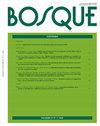Biosolids as planting fertilization of tree species of the Atlantic forest and concentration of nutrients in soil layers
IF 0.6
4区 农林科学
引用次数: 1
Abstract
Sewage sludge biosolids, product from urban sewage treatment, are rich in organic matter and nutrients with potential use in forestry. This work aimed at evaluating the growth of Ceiba speciosa, Peltophorum dubium and Sapindus saponaria and the concentration of nutrients and heavy metals in different soil layers under the application of biosolids as planting fertilizer. Two sequential experiments were set up. First in a pot, to determine the best dose for the growth of C. speciosa, using 0.8, 1.6, 3.2 and 6.4 liters of biosolids per pit and the absolute witness. Six months after the planting of C. speciosa seedlings, it was concluded that the best dose provided was around 3.9 liters. The field experiment was carried out using the three tree species with witness treatment or application of 3.0 liters of biosolids per pit, at the time of planting. Growth evaluations occurred at 4 and 12 months after planting and it was observed that C. speciosa and P. dubium responded to the application of biosolids. At 12 months, nitrogen, phosphorus, potassium and heavy metals contents were evaluated in different layers of the soil. It was found that the pits that received biosolids presented significantly higher values for phosphorus (except 75-100 cm soil layer) and heavy metals. There was no leaching of nitrogen, phosphorus and potassium in the soil layers. Heavy metals contents were below the maximum values for levels in the soil profile stipulated by legislation.生物固体作为大西洋森林树种的种植施肥和土层养分浓度
污泥生物固体是城市污水处理的产物,富含有机物和营养物质,有可能用于林业。本研究旨在评价在施用生物固体作为种植肥料的情况下,Ceiba speciosa、Peltophorum dubium和Sapindus saponaria的生长以及不同土层中营养物质和重金属的浓度。设置了两个连续的实验。首先在一个罐子里,用0.8、1.6、3.2和6.4升的生物固体和绝对见证物来确定物种C.speciosa生长的最佳剂量。在种植C.speciosa幼苗六个月后,得出的结论是提供的最佳剂量约为3.9升。在种植时,使用三种树种进行田间试验,每个坑进行见证处理或施用3.0升生物固体。在种植后4个月和12个月进行生长评估,观察到C.speciosa和P.dubium对施用生物固体有反应。在12个月时,对不同土壤层的氮、磷、钾和重金属含量进行了评估。研究发现,接受生物固体的坑中磷(75-100厘米土层除外)和重金属的含量明显较高。土层中氮、磷、钾均未发生淋失。重金属含量低于法律规定的土壤剖面水平的最大值。
本文章由计算机程序翻译,如有差异,请以英文原文为准。
求助全文
约1分钟内获得全文
求助全文
来源期刊

BOSQUE
Agricultural and Biological Sciences-Forestry
CiteScore
0.70
自引率
0.00%
发文量
0
期刊介绍:
BOSQUE publishes original works in the field of management and production of forestry resources, wood science and technology, silviculture, forestry ecology, natural resources conservation, and rural development associated with forest ecosystems. Contributions may be articles, rewiews, notes or opinions, Either in Spanish or English.
 求助内容:
求助内容: 应助结果提醒方式:
应助结果提醒方式:


